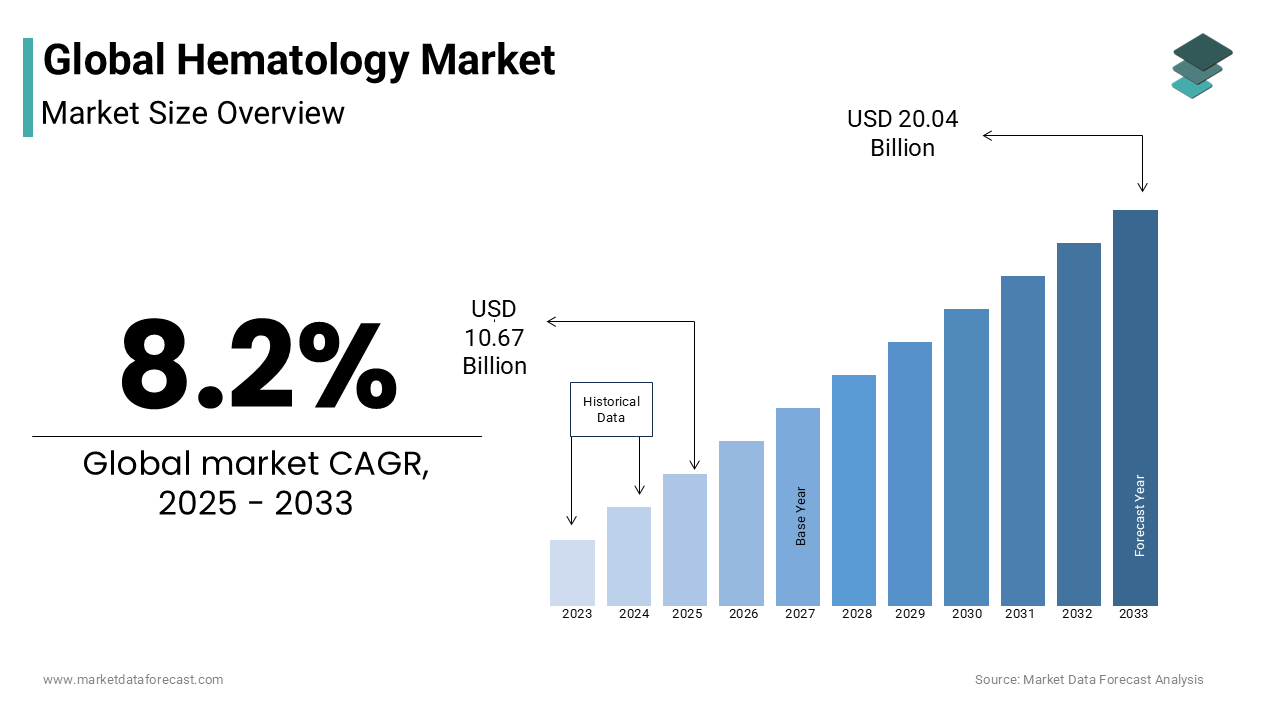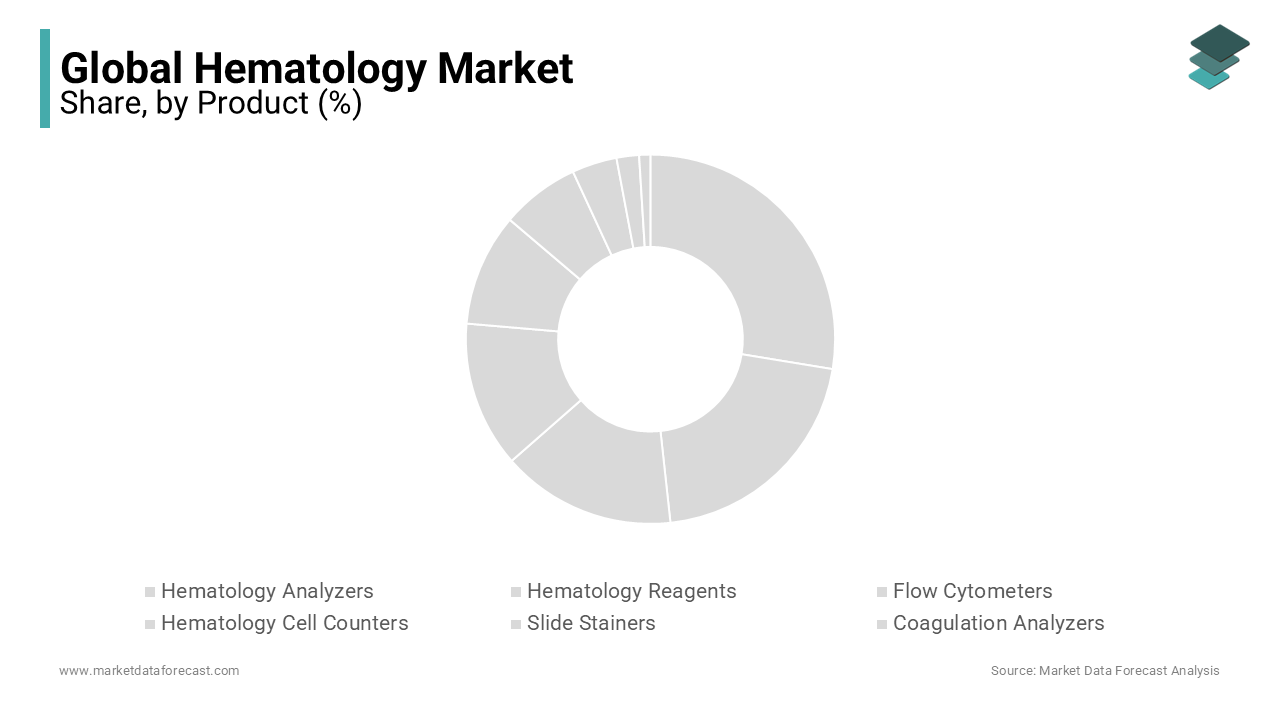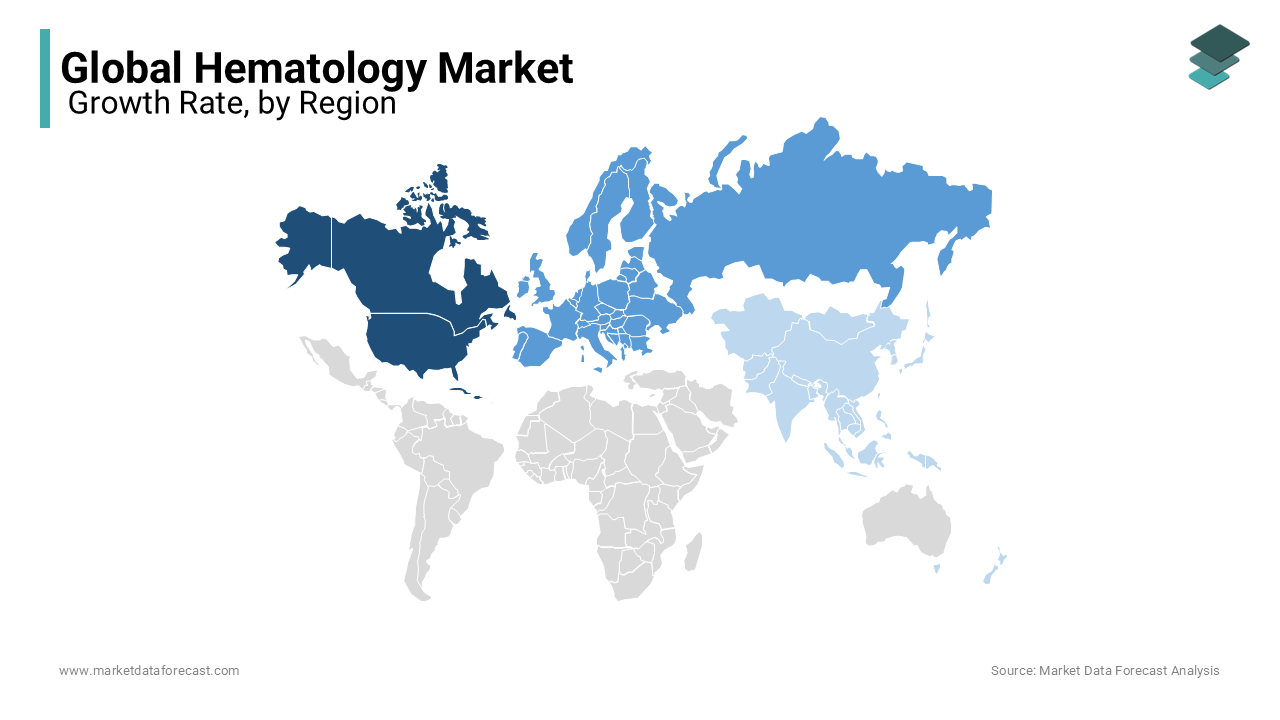Global Hematology Market Size, Share, Trends & Growth Forecast Report – Segmented By Product (Hematology Analyzers, Hematology Reagents, Flow Cytometers, Hematology Cell Counters, Slide Stainers, Coagulation Analyzers, Hematology Testing, Centrifuges, Hemoglobinometers and Others), Application, End-User and Region (North America, Europe, Asia Pacific, Latin America, and Middle East & Africa) - Industry Analysis From 2025 to 2033
Global Hematology Market Size
The global hematology market size was valued at USD 9.86 billion in 2024. The market is forecasted to grow at a healthy CAGR of 8.2% from 2025 to 2033. As a result, the market size is estimated to grow from USD 10.67 billion in 2025 to USD 20.04 billion by 2033.

Current Scenario of the Global Hematology Market
Hematology is a medical science branch concerned with diagnosing, treating, and studying blood and disorders associated with blood. It includes treating blood disorders such as leukemia, malignancies, hemophilia, sickle-cell anemia, and lymphoma. Hematology refers to the scientific branch of the study of blood, its diseases, treatments, and malignancies, including hemophilia, blood clots, leukemia, lymphoma, myeloma, and sickle-cell anemia. Among the hematology procedures, blood count or CBC is categorized as the most common test. The blood chemistry test, blood enzyme test, and blood tests to assess heart disease risk are examples of some more tests.
MARKET DRIVERS
The rising prevalence of blood disorders is majorly propelling the global hematology market growth.
Blood disorders have become a worldwide health issue with different causes and are related to high mortality. Blood disorders like anemia, blood cancer, hemorrhagic conditions, and blood infections affect people across all age groups annually. According to WHO, insufficient hemoglobin affects 75% of births globally, and sickle cell trait affects an estimated one in 12 African Americans. Over 70% of all sickle-cell-affected births occur in Africa. As per the WHO, the prevalence of anemia in children is 47% and 13% in men, and it is increasing rapidly worldwide. According to the National Institute of Health (NIH), anemia affects 29% of women of reproductive age and 38% of pregnant women worldwide.
The rising number of blood donation camps worldwide is a significant factor promoting the growth of the hematology market. In addition, growing incidences of chronic diseases, the YOY rise in the geriatric population, and the increasing prevalence of point-of-care testing devices are anticipated to fuel the growth rate of the hematology market. Furthermore, with increasing support from the government through investments, people's interest in cost-effective diagnosis procedures favors the hematology market.
Due to the rising prevalence in the study of hematological malignancies, hemoglobinopathy, anemia, and coagulopathy, which are also regarded as the four main areas of study in hematology, as a result of increasing chronic disorders, it is expected to drive the hematology market. Among these, hemoglobinopathy is the most studied area, which involves the study of an abnormality in the globin chains of hemoglobin molecules, including sickle cell anemia and thalassemia, which are a part of hemoglobinopathy.
There has been a rise in hematologists globally due to their excellent counseling to patients, working closely with experts from various medical and surgical specialties, most commonly with oncologists, to provide intense care to adults and children for cancers of blood and bone marrow, leukemia, and lymphoma. They are also usually associated with pathologists, called hematopathologists or hematopathologists through specialization in diagnosing hematological diseases, who work together with hematologists to formulate diagnoses, such as for the treatment of bleeding disorders hemophilia and idiopathic thrombocytopenic purpura, treatment of hematological malignancies, and the treatment of hemoglobinopathies bone marrow and stem cell transplantation. These factors are leading to the drive of the hematology market.
MARKET RESTRAINTS
However, the need for sufficient knowledge of the devices in rural areas is slowly hindering the growth of the hematology market. In addition, the high cost of installing and maintaining the equipment, especially in laboratories, is challenging for the hematology market.
REPORT COVERAGE
|
REPORT METRIC |
DETAILS |
|
Market Size Available |
2024 to 2033 |
|
Base Year |
2024 |
|
Forecast Period |
2025 to 2033 |
|
Segments Covered |
By Product, Application, End-User, and Region. |
|
Various Analyses Covered |
Global, Regional & Country Level Analysis, Segment-Level Analysis; DROC, PESTLE Analysis, Porter's Five Forces Analysis, Competitive Landscape, Analyst Overview of Investment Opportunities |
|
Regions Covered |
North America, Europe, APAC, Latin America, Middle East & Africa |
|
Market Leader Profiled |
Siemens AG Healthcare, Johnson & Johnson, Beckman Coulter, Inc., Abbott Laboratories, Thermo Fisher Scientific, Roche, HORIBA Ltd., Sysmex Corporation, Bio-Rad Laboratories Inc., Boule Diagnostics AB, Mindray Medical International Limited. |
SEGMENTAL ANALYSIS
By Product Insights
The hematology analyzers segment is the most promising and is expected to register a healthy growth rate during the forecast period. Increasing incidences of road accidents due to a rise in the demand to store blood, which can be used in emergencies, significantly influences the market's growth. Hematology analyzers are used in the medical field to perform tests on blood samples for complete blood counts, coagulation tests, white blood cell counts, and reticulocyte analyses, which is helpful for research laboratories and veterinarians. Some allow choosing the preferred test type; others consider sample size, speed, type, and the number of test modes. They are called cell counters due to the counting of hematocrit and hematocrit levels, along with CBC.

The hematology cell counters segment is anticipated to account for a substantial market share during the forecast period owing to their wide adoption for diagnosing and monitoring most blood-related disorders. It is also called CBC and involves drawing blood by inserting a needle into a vein to let it into a tube.
The hemoglobinometers segment is foreseen to register a steady CAGR during the forecast period. These are used as a standard method for measuring the hemoglobin content of the blood. This device compares the color through light bypass over a hemolyzed blood sample.
By Application Insights
The infectious disease segment is predicted to lead the global hematology market during the forecast period due to the increasing incidences of various health disorders. Also, the rise in healthcare centers' spending further accelerates the segment's growth.
The cancer segment is anticipated to hold a substantial share of the global hematology market during the forecast period owing to rising cancer cases, leading to hematological oncologists growth, which specializes in hematology, the study of blood, and oncology, the study of cancer, for treatment, diagnosis, and prevention of blood cancers and blood-related disorders.
The CVDs segment is also expected to register healthy growth during the forecast period. Cardiovascular disorders are rising, leading to the expectation of high growth in this segment. This led to creating new and exciting fields, cardio-oncology and cardio-hematology, attracted by amyloidosis with clonal hematopoiesis of undetermined potential.
By End-User Insights
The hospital end-user segment is forecasted to dominate the global hematology market during the forecast period. The growing constructional activities of hospitals due to the increasing flow of patients with varied diseases are accelerating the market's growth. In addition, the rising prevalence of minimally invasive surgeries to cure the conditions more effectively with available treatment options is ascribed to bolstering the growth of the hematology market.
The clinics segment is foreseen to project a healthy CAGR during the forecast period. Clinical hematology laboratories are widely used in performing various basic and advanced hematology tests on serum, whole blood, cerebrospinal fluid, urine, and other bodily fluids.
The diagnostic laboratories segment is anticipated to register a steady CAGR during the forecast period. Diagnostic laboratories help perform advanced hematology testing using advanced techniques like flow cytometry-based methods and electrophoresis.
REGIONAL ANALYSIS

The North American hematology market accounted for the largest share of the global hematology products and services market in 2023, followed by Europe. Some factors, such as the rising incidence of patients suffering from blood disorders, the high number of patients with blood coagulation disorders, the growing prevalence of target diseases, and blood transfusions, are increasing hematology testing in North America.
On the other hand, the Europe hematology market is predicted to have a healthy CAGR in the coming years. In addition, the rise in per capita income leading to an increase in the adoption of therapy products and diagnostics coupled with government initiatives to improve healthcare infrastructure are expected to fuel the regional market growth. Europe has been growing faster in past years and will continue to have the same growth rate in foreseen years. Furthermore, replacing traditional testing devices with modern devices broadens the market's demand.
Following North America, the Asia pacific hematology market is anticipated to register the fastest CAGR during the forecast period. The increasing population and rising awareness of over-utilizing the latest technology are leveraging this market's growth in this region.
KEY MARKET PLAYERS
Some of the major companies dominating the global hematology market profiled in this report are Siemens AG Healthcare, Johnson & Johnson, Beckman Coulter, Inc., Abbott Laboratories, Thermo Fisher Scientific, Roche, HORIBA Ltd., Sysmex Corporation, Bio-Rad Laboratories Inc., Boule Diagnostics AB, Mindray Medical International Limited.
RECENT HAPPENINGS IN THE MARKET
- In November 2022, EKF Diagnostics, a global in vitro diagnostics company, improved DiaSpect Tm for its connection with the newly released EKF Link analyzer for ensuring securely stored and accessible test results, which is now also equipped with Bluetooth and internal storage to provide a calculated hematocrit value with the usual hemoglobin result.
- In November 2022, according to data from a phase 1 study by Society for Immunotherapy on cancer, the first personalized cell therapy was shown to be safe in solid tumors using gene replacement, which also led the researchers to find a higher frequency of transgenic neo-antigen compared to the pre-infusion level of wild-type TCRs, in post-infusion tumor biopsies.
- In June 2018, the partnership between Beckman Coulter Diagnostics and the University of California fuelled the research measures in hematology and supported innovative products.
- In May 2018, Beckman Coulter launched the DxH 900 hematology analyzer, which performs complete blood count and white blood cell differential tests in clinical laboratories with minimal repeats.
- In March 2018, the Cobas m 511 integrated hematology analyzer was developed by Cobas and Roche Diagnostics Hematology, Inc. and received approval from the FDA (Food and Drug Administration). A digital morphology analyzer, cell counter, and classifier are integrated into a streamlined instrument for preparing, staining, and analyzing microscopy blood slides.
- The Yumizen G ranges from semi to fully Horiba launched automated hemostasis solutions in February 2018, which this product has strengthened the company's position in the market.
MARKET SEGMENTATION
The research report on the global hematology market has been segmented and sub-segmented based on the product, application, end-user, and region.
By Product
- Hematology Analyzers
- Hematology Reagents
- Flow Cytometers
- Hematology Cell Counters
- Slide Stainers
- Coagulation Analyzers
- Hematology Testing
- Centrifuges
- Hemoglobinometers
- Others
By Application
- Infectious Diseases
- Cancer
- Cardiovascular Disorders
- Blood Screening
- Diabetes
- HIV
- Auto-Immune Diseases
By End-User
- Hospitals
- Clinics
- Diagnostic Laboratories
- Research and Development Centers
- Others
By Region
- North America
- Europe
- Asia Pacific
- Latin America
- Middle East and Africa
Frequently Asked Questions
Does this report include COVID-19 impact on the hematology market?
COVID-19 accelerated the hematology market growth. In this report, a detailed analysis of how has COVID-19 impacted the hematology market is included in this report.
Which region had the major share in the global hematology market in 2024?
Geographically, the North American region accounted for a promising share in the global market in 2024.
What are some of the prominent companies in the hematology market?
Siemens AG Healthcare, Johnson & Johnson, Beckman Coulter, Inc., Abbott Laboratories, Thermo Fisher Scientific, Roche, HORIBA Ltd., Sysmex Corporation, Bio-Rad Laboratories Inc., Boule Diagnostics AB, Mindray Medical International Limited are a few of the key players in the hematology market.
Related Reports
Access the study in MULTIPLE FORMATS
Purchase options starting from
$ 2500
Didn’t find what you’re looking for?
TALK TO OUR ANALYST TEAM
Need something within your budget?
NO WORRIES! WE GOT YOU COVERED!
Call us on: +1 888 702 9696 (U.S Toll Free)
Write to us: sales@marketdataforecast.com
